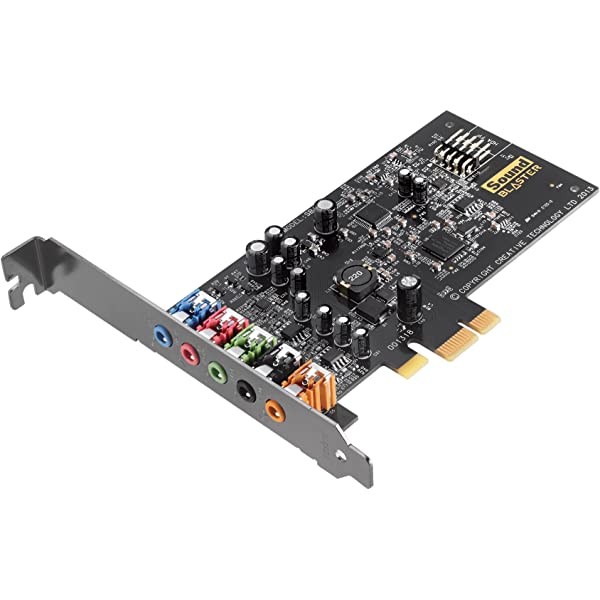
In this Article we discuss that, Top 5 Computer Sound Cards In 2023? Since there are so many different sound cards available, selecting the best one for your system can be difficult. We’ve included some of the best PC sound cards and amplifiers on the market to aid you.
There include PCIe-based alternatives (best suited for desktops), such the ASUS Essence STX II, and USB-powered devices, like the Creative Sound BlasterX G6, which are great for laptops and game consoles.
1.Creative Sound Blaster Z

The Sound Blaster Z from Creative is unquestionably one of the greatest PC sound cards available today, offering a wealth of capabilities at an affordable price. With a Signal-to-Noise Ratio (SNR) of 116dB and the ability to output audio at 24-bit/192kHz, you can fully appreciate high-resolution music. For decreased audio latency, it also supports Audio Stream Input/Output (ASIO). Without burdening the computer’s main CPU, the card’s dedicated “Sound Core3D” audio processor improves the overall sound and voice quality.
The Sound Blaster Z features five gold-plated 3.5mm audio ports and two TOSLINK ports for connectivity and I/O, allowing you to connect anything from headphones to home theatre system(s) and enjoy high-fidelity immersive digital audio. A beamforming microphone that reduces background noise and creates an acoustic zone is also included with the PCIe sound card, improving voice quality.
2. ASUS Xonar SE Gaming Sound Card

If you’re one of those people who can’t afford to spend a boatload on high-end computer hardware, ASUS’ Xonar SE is exactly what you need. This low-cost PC sound card enables high-resolution audio playback (5.1 channel) at up to 24-bit/192kHz and has an SNR of 116dB. Its built-in 300 ohm headphone amplifier also produces immersive audio with distinct bass.
Asus says that its own “Hyper Grounding” fabrication method, used in the card’s production, improves signal insulation and decreases distortion and interference.
The Xonar SE has four 3.5mm audio ports, one S/PDIF port (with TOSLINK), and a front audio header for connectivity and I/O choices. The PCIe sound card has a low-profile mount that makes it easy to install in compact cases and is powered by a Cmedia 6620A audio processor. The companion app makes it simple to configure its audio settings.
3.Creative Sound Blaster AE-7

One of the most powerful PC sound cards currently on the market, Creative’s Sound Blaster AE-7 supports 32-bit/384kHz audio playback and has a Signal-to-Noise Ratio (SNR) of 127dB. Together with the ESS SABRE-class 9018 Digital-to-Analog Converter (DAC), it also includes an integrated 600 ohm headphone amplifier that produces 7.1 channel surround sound for headphones and 5.1 channel for speakers.
The associated “Audio Control Module” unit, which has a handy knob for volume adjustment, is the card’s best feature, though. For convenient I/O and communication, it also contains a built-in microphone array, two 3.5mm audio connectors, and two 6.3mm audio ports.
There are five 3.5mm audio ports and a TOSLINK port on the Sound Blaster AE-7. A specialised “Sound Core3D” audio processor powers the PCIe sound card. Via its associated software utility, you can change parameters (such as recording resolution and encoding format).
Read More:How to Purchase a Television in 2023?
4. Creative Sound BlasterX G6

Internal sound cards are excellent but are only compatible with PCs due to their PCIe extension bus interface. The Sound BlasterX G6 from Creative is powered by USB, so that is not a problem. This indicates that you can connect it to game consoles like the Xbox One, PlayStation 4, and Nintendo Switch in addition to laptops and desktop computers. It supports 32-bit/384kHz high-fidelity audio and has an integrated Digital-to-Analog Converter (DAC) with a Signal-to-Noise Ratio (SNR) of 130dB.
Moreover, the external sound card has a separate 600 ohm headphone amplifier that enhances each audio channel separately. The Sound BlasterX G6 has two 3.5mm audio ports, two optical TOSLINK connections, and a micro USB port for connectivity and I/O possibilities. To simply adjust the level of the microphone and gameplay audio, you receive a single side-mounted dial. Everything, including Dolby Digital effects and noise reduction settings, may be changed via the companion app.
5. FiiO E10K

FiiO’s E10K is small enough to nestle in the palm of your hand, measuring around 3.14 x 1.93 x 0.82 inches and weighs only 2.75 ounces. A portable Digital-to-Analog Converter (DAC) that can decode 24-bit/96kHz high-resolution audio without breaking a sweat is what is being discussed here; it is not a sound card. This is made possible by its brand-new PCM5102 chip, which improves the linearity of the internal digital filter for better audio output.
The new LMH6643 op-amp inside transforms the device into a 150 ohm headphone amplifier, and you also receive a Signal-to-Noise Ratio (SNR) of 108dB. The E10K has two 3.5mm audio ports, one coaxial audio port, and a MicroUSB connector for I/O and communication. A handy volume control dial and a thin aluminium shell with a brushed metal finish are a few of additional standout characteristics.
What to Look for in a PC Sound Card
Audio quality
An intricate calculation that considers the signal-to-noise ratio, frequency response, and total harmonic distortion determines the overall audio quality of a sound card. The finest sound cards have a signal-to-noise ratio of 124dB, which is a significant improvement above the industry standard of 100dB.
Channels
Although 5.1 channel audio is commonly supported by many good, affordable sound cards, you can spend a little more to get one that can handle 7.1 surround sound. Some can even upmix 5.1 channel audio to 7.1 channels, which is great if your headphones can handle it but your audio sources can’t.
Connectivity
Find a sound card with the jacks you require to connect your devices. If you’re connecting to audio equipment that needs such types of connections, search for a sound card with RCA jacks or a TOSLINK optical connection instead of the standard 3.5mm ports found on most headphones and headsets.
Conclusion
Before delving into the future of computer sound cards, it is essential to understand what they are and how they work. A sound card, also known as an audio card or audio interface, is a device that converts digital audio signals into analog audio signals that can be played through speakers or headphones.
sound cards have come a long way since their inception, and as we move into 2023, the future of audio technology looks bright. With advancements in virtual surround sound, high-resolution audio, compatibility, and advanced features, computer sound cards are set to deliver an even better audio experience.












4 Comments